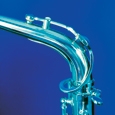The beauty of the saxophone is that so many distinctly different, but equally captivating, sounds can be produced. Just as every voice is different, every saxophonist can develop a personal sound, much as John Coltrane, Stan Getz, and Marcel Mule each had a distinct sound. The saxophone possesses the widest tonal spectrum of any of the wind instruments, but in this extremely large range of possible sounds, many of them are unacceptable in ensemble playing. Applying a few standard principles will help students develop a good personal sound, which is a far more abstract concept than technique. It is a process of long-term improvement and dedicated maintenance.
Embouchure
The first step is solely in the embouchure formation of the student. Often, a saxophone section producing harsh or strident sounds worsens a band’s tone color. During early instruction on the instrument, students should learn that simply making a sound is not the primary achievement; saxophones allow for sound to be produced with virtually any type of embouchure shape. It is important that students learn to differentiate between good and poor tone.
Monitoring embouchure shape as early as possible lays the foundation for a more desirable tone. The difficulty is balancing the instant gratification of producing a sound against the work of forming an appropriate embouchure. With beginners there should be praise for the production of any sound, but a heavy focus on fundamental exercises should continue until the tone is produced with a correct embouchure shape. Students will have much more interest in learning new notes than studying the finer points of embouchure formation, but technique will come much more quickly than tone. Furthermore, it is far easier for a student to change embouchure shape at a young age than after years of playing with an incorrect embouchure.
A correct embouchure shape has several components that must work simultaneously, the first of which is the top teeth. Students frequently underestimate the importance of the top teeth on the mouthpiece. It is not enough simply to place the teeth on top of the mouthpiece; all the weight of the head should sit on top of the mouthpiece. The neck strap is often too high to allow gravity to push the weight of the head down. Check the height of the neck strap during instruction when analyzing this component. To test the front teeth, gently pull the saxophone, by the underside of the curved portion of the neck, while a student is playing. If the instrument flies out of the student’s mouth, the teeth are not firm enough on the mouthpiece. It is important to find a balance between allowing the weight of the head to be pushed down by gravity and not biting or clamping the jaw to keep the mouthpiece from moving.
The second aspect of the embouchure is the lower lip, which helps determine the amount of reed vibration present in the tone color. Too much lip in contact with the reed mutes the sound and, in extreme cases, will prevent students from playing the highest pitches at all. Too much lip will also make the tone brighter and louder. Although this is a good technique to use while playing jazz, it should be closely monitored on beginners in concert band.
Finding the correct proportion of lower lip can sometimes prove difficult. The pink color of the inside of the lip gives teachers clues about how much lip is in contact with the reed. If the smooth underside of the lip is present, then the lip is rolled out too far. If no pink is visible, the student is likely inhibiting the reed’s vibrations. The most efficient way to correct this is with a mirror, so students can then see what they are doing with the lip. Allow students to experiment with the sounds produced by different lip positions. It will take days of mirror use and relentless monitoring before a revised lip placement becomes automatic. This can be frustrating because students can make a sound even if the lower lip placement is incorrect and may not understand why such an emphasis is placed on the lip position.
The corners of the mouth are also important to saxophone tone. Many people describe the embouchure as a drawstring bag, with the top teeth, lower lip, and corners all working together to create an O shape. Frequently students forget to tighten corners of the mouth; bringing them forward slightly, as a contributing component of the O shape analogy, frequently improves the sound. If the corners are too far forward, however, that could hinder the sound.
Equipment
The reed has the largest influence on sound production. It is essential to have multiple reeds in good working order. Often, students get a new reed and play it until it breaks or no longer makes any sound. This is detrimental to tonal development. It is best to require students to establish a rotation of four or more reeds. This makes reeds last longer and gives students a more consistent sound from day to day. Storage of reeds is also essential to tone production. Reeds should never be stored on the mouthpiece or in the thin plastic in which they arrive. Inexpensive reed guards exist to keep the reed flat while drying, which prevents warping.
The mouthpiece also affects sound. Many different types exist with slight variations, but the most important thing for young students to learn is to protect the mouthpiece. It should be stored with a protective cap, because a wide range of chips and cracks can occur to essential areas of the mouthpiece if students neglect to use the cap. Chips and cracks in the mouthpiece will cause numerous tonal problems and are costly to repair or replace.
Listening
A simple survey of any school age saxophone section will likely provide alarming information about the lack of saxophone listening. Saxophone students sometimes play for years without ever hearing a recording of a master on their instrument, but listening is one of the best ways for students to develop a characteristic sound. Given that the saxophone only rarely appears in the orchestra, the educator must help students seek out classical recordings. Students can hear examples of clear sounds in the low register and full rich sonorities in the high register, as well as see other problems they may face demonstrated correctly. They should be taught to listen for appropriate vibrato usage and phrasing possibilities on the instrument. Students can learn of pieces they wish to play themselves, become inspired by other artists’ technical or lyrical abilities, or find favorite recordings to share with other students.
Students can master technique, rhythm, and articulation, but these accomplishments pale compared to the ability to produce a beautiful tone. With guidance, students can develop a saxophone tone that is both personal and beautiful.
* * * *
Recommended Recordings
Classical:
Claude Delangle – Under the Sign of the Sun
Timothy McAllister – Duo Nuova
Arno Bornkamp – The Classical Saxophone
Otis Murphy – Fantasy
Eugene Rousseau – Saxophone Concertos
Jazz:
John Coltrane – Giant Steps
Sonny Rollins – Saxophone Colossus
Chris Potter – Gratitude
Charlie Parker – Diz N Bird at Carnegie Hall
Kenny Garrett – Standard of Language






